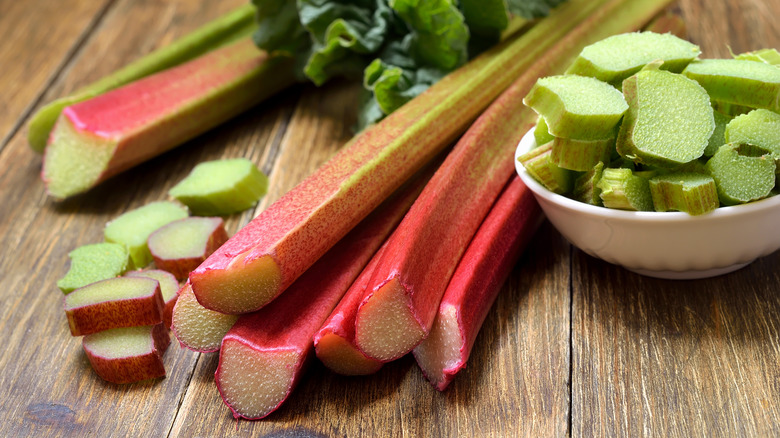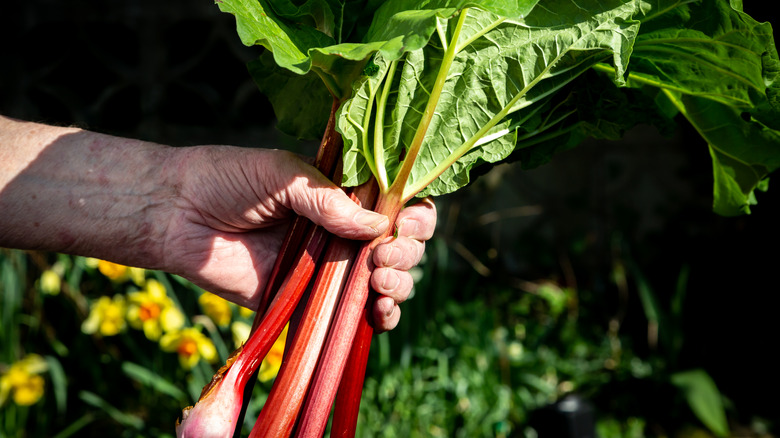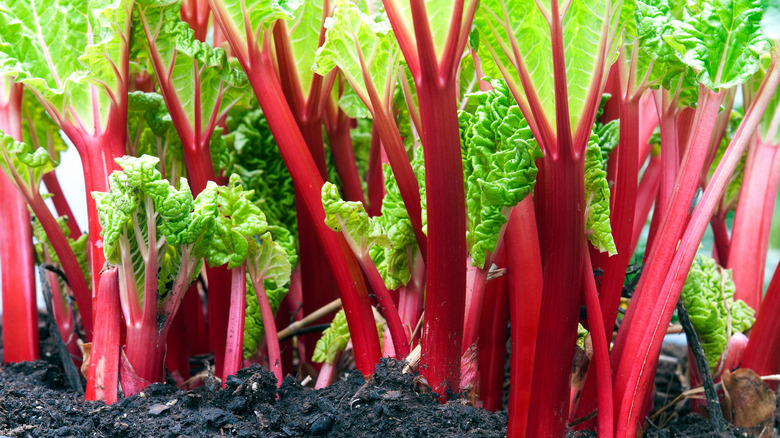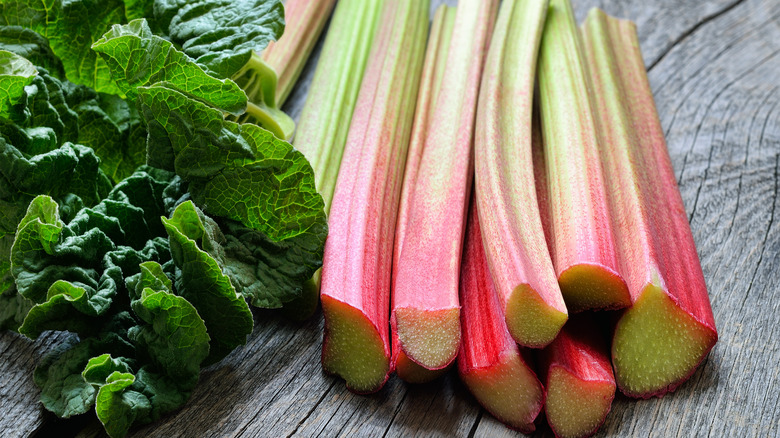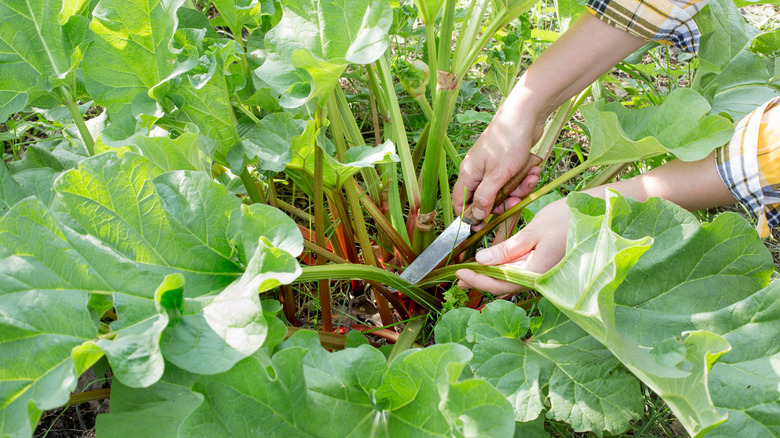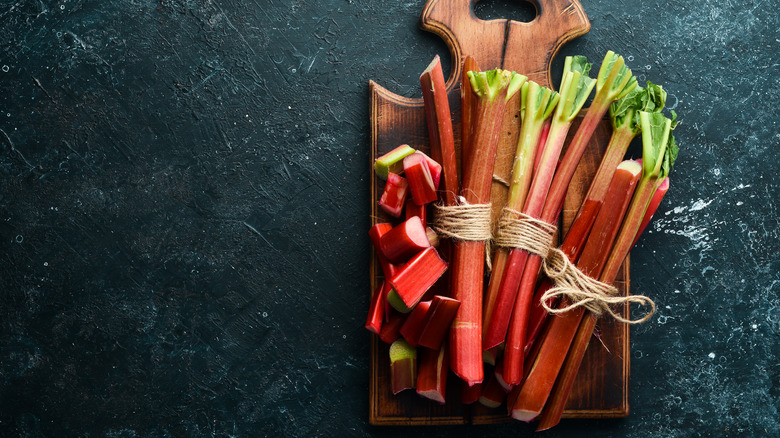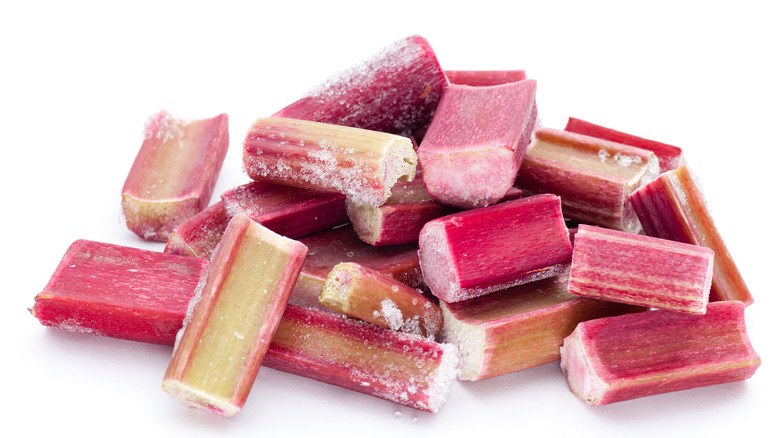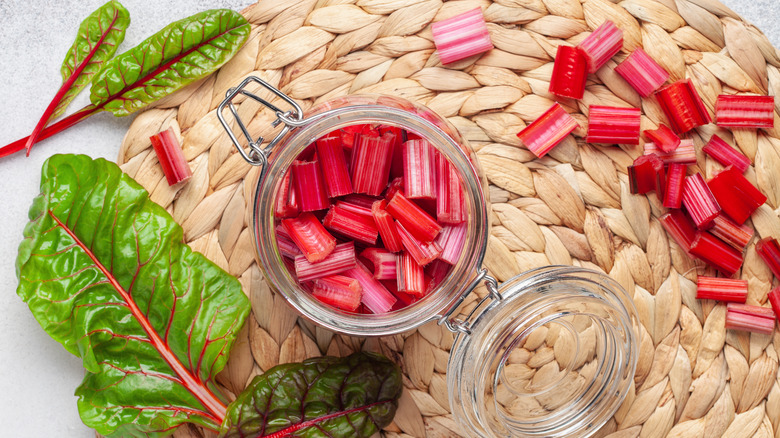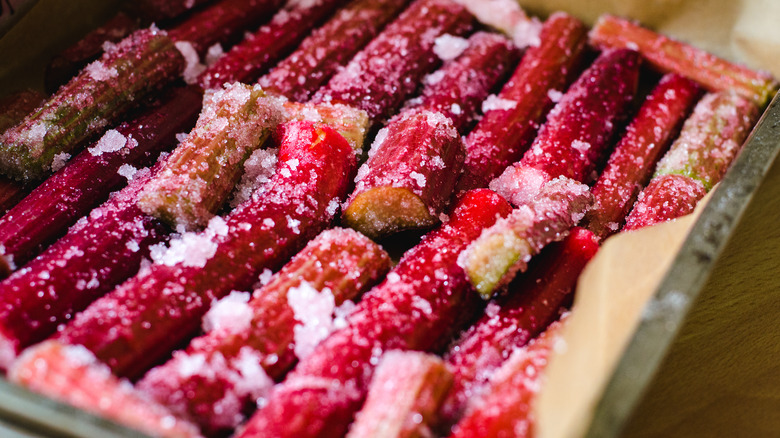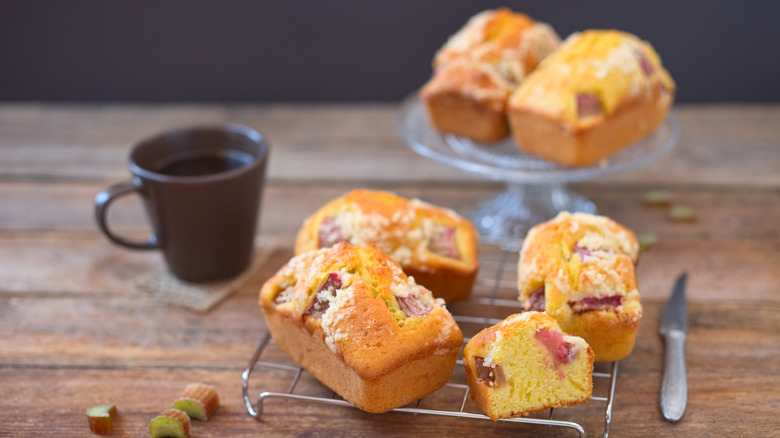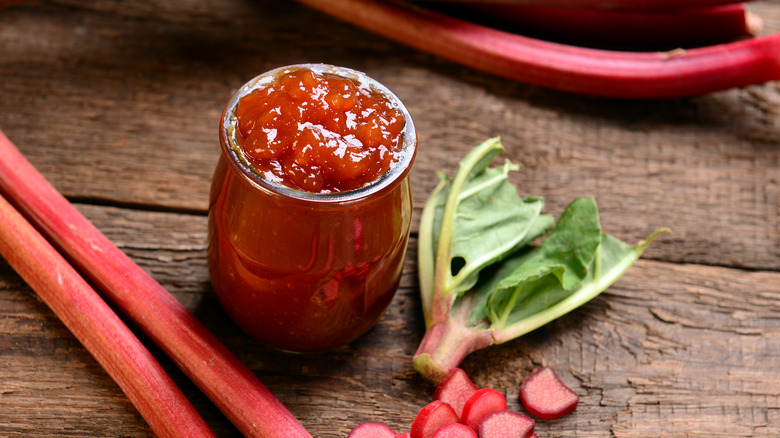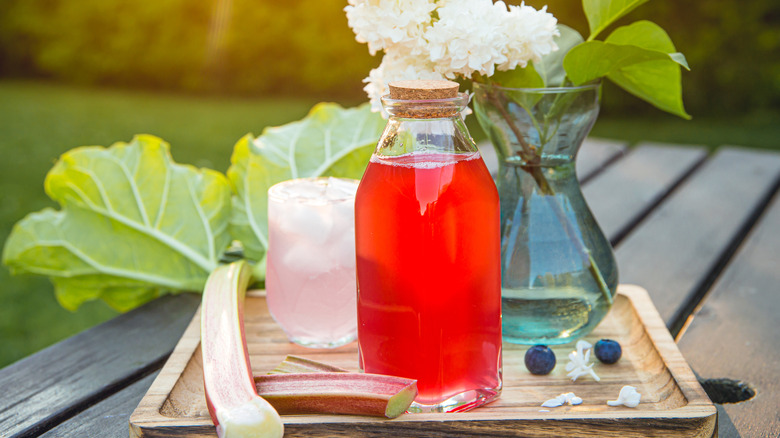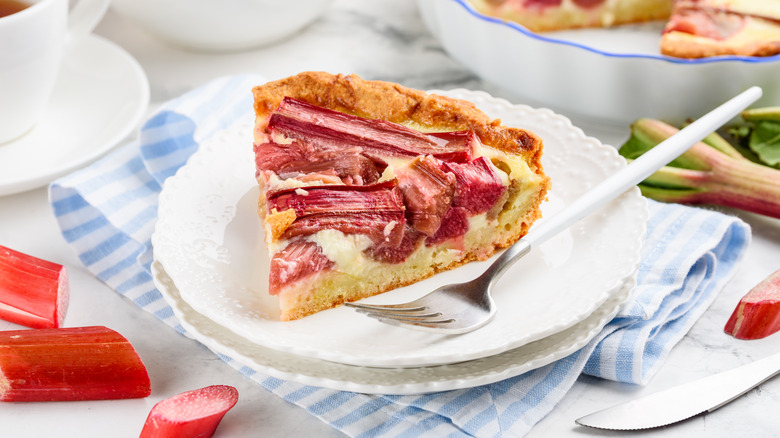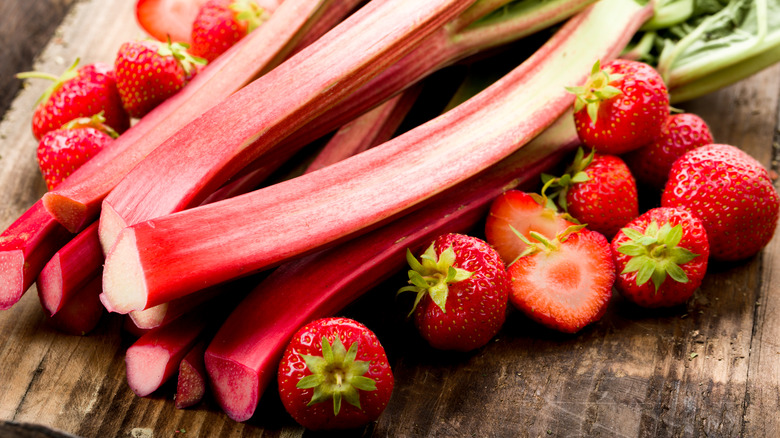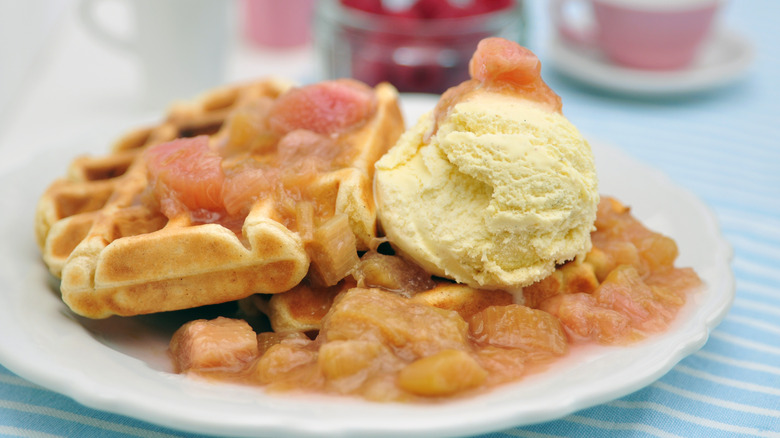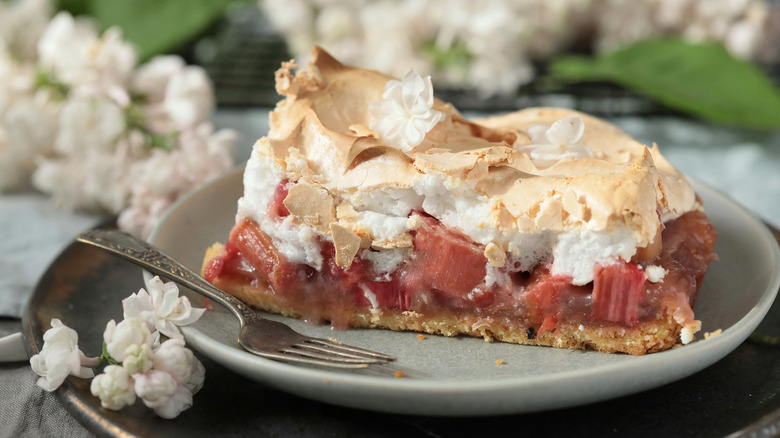15 Tips You Need When Cooking With Rhubarb
When heaps of crimson stalks show up in the farmer's market, you realize it's that time of the year again: Time for a rhubarb pie, tart, or cake. With its apparent celery similarity, deep reddish hue, super tangy taste, and flavors reminiscent of apple and grape when cooked, rhubarb is a well-known vegetable with some interesting culinary uses.
The tangy (sometimes citrusy) flavor of rhubarb makes it easy to combine with anything sweet or become part of a dessert. But the plant was not always treated as such. According to High Altitude Rhubarb, the first uses for the vegetable were documented about 5,000 years ago in Chinese medicine. In ancient times, the plant's roots were considered a good laxative, a use that the ancient Greeks and Romans also documented. However, only in the 19th century did rhubarb become a dessert ingredient, as this was when sugar became widely available. Whether you're already a fan of this vegetable or are just starting to discover its many qualities, here are some tips you should know when cooking with rhubarb.
Harvest rhubarb in the spring
Rhubarb is one of the first plants to be ready to harvest in spring, as it starts growing at a vigorous pace in the early spring months. Depending on the plant's health and growth, you can start harvesting rhubarb mid-spring and continue until fall. However, the best time to harvest rhubarb depends on the climate and your plant. It's advisable to avoid harvesting rhubarb in the first year after planting so it has enough time to mature.
Need a tip to make your rhubarb harvesting easier? Twist the stalks, and don't cut them. The main reason is that when you cut the stalks, it makes them more vulnerable to different infections, as the plant's wound is slower to close. However, when you twist the stalks and break them, you adapt to the plant's structure, and the wound heals faster. To rotate the stalks, grab them as close to the bottom of the plant as possible, then tug and twist the stem until it separates from the plant.
Pick the right stalks
When you harvest rhubarb, make sure you pick only those stalks that are mature enough but not too old. Color is not an indicator, as different types of rhubarb come in colors ranging from crimson to green. However, ensure that you pay attention to the size of the rhubarb stalks. Don't harvest stalks that are not at least eight inches long, and avoid stalks that are thicker than one inch. Also, avoid harvesting inner stalks (which are usually thinner), since that will weaken the plant.
If you can't harvest rhubarb, there are also a few things you should look for when buying it. Avoid rhubarb stalks with visible blemishes or those that are curled or floppy. These are signs that the plant was harvested a while ago and is no longer fresh. Also, if the rhubarb stalks still have the leaves attached, make sure that these are not wilted. The presence of roots still attached to the stalks indicates the plant's maturity, as roots will come out of the earth only when the plant is ripe. A rhubarb plant that still has its roots attached will last longer than trimmed rhubarb, so try to pick such stalks if you can find them.
Remove the leaves before consumption
Although they are an excellent indicator of the plant's freshness and are similar to chard, rhubarb leaves should be promptly discarded. The reason for this precaution is that rhubarb leaves are toxic. Consume only the stalks of the plant, as the level of oxalic acid — the toxic substance found in the plant — is much lower in the stalks than in the leaves. However, the leaves contain concentrations ranging from 570 to 1,900 milligrams of oxalate per 100 grams, enough to make you very sick.
Rhubarb leaf poisoning comes with nausea, vomiting, diarrhea, and problems with swallowing. Not to worry, though — rhubarb leaves are not lethal to humans, as you would have to ingest a large quantity for the plant to kill you. Still, to avoid any problems, simply cut off the leaves and discard them right away. You can always use them for compost, as they will not cause any issues in this form.
Keep the leaves away from pets
Because of the higher level of oxalic acid in rhubarb leaves, they should be kept away from pets. According to Utah State University, poisoning symptoms sometimes appear in cattle that accidentally graze on rhubarb leaves. House pets like dogs are unlikely to eat the leaves since they taste bitter. However, they should be kept away from animals, as they can have more potent poisonous effects than they do in humans. With dogs, they can cause vomiting, irritation, and diarrhea.
Despite their toxicity, though, rhubarb leaves can be a good fertilizer for your other plants. Make a concentrated rhubarb leaf brew by boiling chopped leaves. After boiling for a minute, let the leaves steep for half an hour, strain the liquid, and toss the leaves into the compost pile. The rhubarb brew strengthens plants, prevents potassium deficiency, and eliminates aphids. Make sure you use the rhubarb brew quickly so it doesn't ferment, because this process could damage your plants.
Eat rhubarb for its health benefits
Rhubarb is probably not the first vegetable that comes to mind regarding health benefits. Its sour taste is usually tamed with sugar and is generally associated with desserts, which are not very healthy. But rhubarb actually contains vitamins and antioxidants that can be valuable to your health. It has high quantities of vitamins C and K, fiber, and antioxidants. In addition, rhubarb can provide more than a quarter of the recommended daily intake of vitamin K1 and a significant amount of calcium needed for bone recovery or growth.
According to Healthline, rhubarb is also a good fiber source, which helps lower cholesterol levels. Some studies support this claim, so it's possible that eating rhubarb could help you with this problem. In addition, rhubarb also contains antioxidants from the family of condensed tannins, which can also be found in fruits, red wine, and cocoa. Antioxidants help your body defend itself against potentially harmful molecules named free radicals. Free radicals can accumulate in your cells and increase the risk of heart disease, Type 2 diabetes, and cancer.
Freeze rhubarb to keep it fresh
Although it is only available for a few months, rhubarb reacts well to storing methods. You can refrigerate it for one to two weeks; better yet, it will keep fresh when frozen for up to a year (per Almanac). To keep it in the refrigerator, make sure that you discard any stalk or any stalk piece that has discolored parts. Then, wrap your rhubarb stalks in aluminum foil to preserve their texture and flavor. Aluminum foil is better than plastic when preserving rhubarb as it allows the stalks to aerate, which will keep them crisp. However, avoid crumpling the foil too tightly over the rhubarb, as this will prevent air from circulating, leaving you with soft stalks.
To freeze rhubarb, check each stalk for signs of discoloration and remove any fibers attached to the stalks. Wash the stalks, pat them dry, then cut them into one-inch pieces. Blanching the rhubarb (boiling it for a minute and then placing it in an ice bath) will better preserve its color and flavor. After the rhubarb is dry, freeze it for two hours, then move it to a sealable container. This way, you can keep your rhubarb fresh for almost a year.
Pickled rhubarb makes a unique ingredient
As rhubarb plants produce many stalks, you will most likely end up with lots of them, regardless of whether you harvest or buy them. To make rhubarb recipes, you will only need a small amount of the plant, so you need ways to store it other than freezing. Pickled rhubarb comes to mind as it is an ideal way of enjoying rhubarb all year long. Also, most pickling rhubarb recipes add something to the usual tart taste, as they contain sugar and spices.
This shrimp fried rice with rhubarb recipe is one of a kind because it includes rhubarb in a savory recipe, which doesn't happen very often. In this recipe, pickled rhubarb is prepared in advance — at least two days before — by combining the vegetable with many different flavors. However, this pickled rhubarb version can be stored in the fridge for up to one month. To make the brine for the pickled rhubarb, cook water with rice vinegar, sugar, kosher salt, mustard seeds, black peppercorns, and one garlic clove until the sugar dissolves. When the brine is cooled, pour it over the rhubarb stalks, which were previously cut into two-inch pieces. Pickled rhubarb goes well with shrimp fried rice and as a topping on burgers or bruschetta.
Combine rhubarb with sugar to balance the flavor
Rhubarb has an interesting status, as it is technically a vegetable but is primarily included in sweet dishes and desserts, so it is perceived as a fruit. According to the U.S. Department of Agriculture, rhubarb is considered a fruit. So much so that it is combined with sugar in almost all recipes. In fact, it's so tart that rhubarb juice is practically impossible to drink when unsweetened.
For this reason, coating rhubarb in sugar while baking and combining it with sugar work very well. If you want to drink rhubarb juice but are avoiding sugar, try mixing it with apple juice or orange juice, which are both much sweeter. Also, keep in mind that if you pick your rhubarb earlier in the spring, there's a slight possibility that you will end up with thinner, crimson-colored stalks that are less tart than fully matured stalks picked later in the year.
Coat rhubarb in flour for baked goods
The tangy-sweet combination of rhubarb and pound cake is often avoided because rhubarb sometimes turns mushy when baked. When this happens, you end up with a not-so-great-looking pound cake and undercooked batter surrounding the crimson veggie pieces. The solution? Coat the rhubarb in flour before mixing it into the batter. As a result, the flour will absorb some moisture, the rhubarb will retain its shape and color, and the batter will cook evenly. Win-win situation, right?
This reinterpreted rhubarb pound cake with black cream recipe delivers perfectly baked crimson rhubarb and combines the tangy vegetable with equally full-flavored ingredients, such as cardamom and black tea. The pound cake batter contains Greek yogurt, butter, flour, sugar, and eggs. In addition, it is flavored with orange zest, vanilla, and cardamom. These notes work wonderfully with the rhubarb and the black tea-infused cream used to serve the cake. All in all, the recipe offers a spectacular flavor combination.
Use it in sweet or savory jams
Another way to preserve rhubarb and enjoy its unique flavor is to turn it into jam. You can use it by itself in a jam or make several different combinations, depending on your preferences. However, rhubarb is perfect for adding that level of acidity which every jam needs, no matter how you choose to combine it. So try some classic combinations, such as strawberry-rhubarb, pineapple-rhubarb, and orange-rhubarb. Or be bold and try this rhubarb-beer jam recipe, perfect for eating with goat cheese, lamb chops, or duck breast. The recipe basically requires that you simmer rhubarb, sugar, lemon juice, and lemon zest in beer, then let it rest. After that, simmer the composition until it thickens and pour it into sterilized jars.
Another original way to jam rhubarb is to make a savory jam. Savory jams are highly versatile and work great with charcuterie and cheese boards. To make a savory jam, combine two or three primary flavors, and make sure to include also an acidic ingredient, a sweet ingredient, and some flavors. For example, rhubarb works great with apples and onions for a savory jam flavored with ginger, allspice, and black pepper.
Select the right ingredients for rhubarb-based drinks
Despite its apparent tartness, rhubarb can work well in a drink when mixed with the right ingredients. It will lend its particular spring-like to any drink, making it refreshing and full of flavor. One way to go is this spiced rhubarb soda recipe, which uses rhubarb cleverly both for the drink and as a side dish to serve with bacon. First, the rhubarb is boiled with sugar, water, lime zest and juice, cardamom, celery seeds, peppercorn, and salt until the rhubarb is very soft. The process is necessary for any rhubarb drink, as the fiber's texture doesn't go well in liquid foods. Then the syrup is strained, and you can drink it with soda water.
Another way to enjoy rhubarb in a drink is to make a shrub. The shrub is a syrup used in 17th century England to preserve vegetables during winter months. It is also called "drinking vinegar," as it is made with fruit (or vegetables), apple cider vinegar, red wine vinegar, sugar, and salt. Rhubarb is ideal for shrubs as it is naturally tart and acidic and works so well when combined with sugar. Shrubs are perfect for cocktails as their acidity and fruit flavors are well-suited for alcoholic drinks.
Add rhubarb for a tangy tart
Rhubarb tart is one of those desserts that can remind you of childhood or conjure all those cozy feelings offered by comfort food. It's a great way to end a meal because it brings together something sweet (the custard), something crunchy (the pastry), and something tangy (the rhubarb). With many international variations (French and British come to mind), rhubarb tart mainly consists of three ingredients — shortcrust pastry, custard, and rhubarb. Unlike pie, tart uses shortcrust pastry to make a shallow shell, which is then filled with custard cream and fruit.
This recipe for strawberry rhubarb custard tart has a flavor twist as it mixes rhubarb with strawberries. The sweet-tangy combination is one of the best things you can do with rhubarb. In this recipe, the rhubarb and strawberries become part of the filling alongside eggs, milk, butter, sugar, and flour, resulting in a great taste of soft cream. And to make things even better, the filling is flavored with cinnamon and nutmeg.
Combine rhubarb with strawberries
If you didn't realize by now, rhubarb and strawberries are an iconic spring combination. It brings together the sweetness of strawberries and the zingy tartness of rhubarb. The result is a beloved explosion, and it's no surprise the combination has become a classic for pies, cakes, fruit bars, or flavored drinks. There are countless recipes in which you can add this combination, whether in solid or liquid form or as part of a more complex dish. For example, add strawberries and rhubarb to applesauce for a flavor twist, make a jam or a compote, add them to a summer fruit salad or peanut butter and jelly sandwich or bake them in cakes, muffins, bars, pies, tarts, or simple crisps.
This easy strawberry rhubarb crisp recipe combines the two fresh flavors and completes the taste and texture with a butter-based crumbly topping made with brown sugar, flour, oats, pecan, and butter. Let the slices of strawberries and rhubarb soak in a sugar-cornstarch mixture for about 10 minutes, cover them with the crumble, and bake your dessert. Then, enjoy it with a dollop of ice cream or whipped cream on top to complete those contrasting textures and flavors.
Rhubarb makes a great addition for waffles
An easy way to enjoy rhubarb's flavor is to incorporate it into your morning waffles. The tangy taste will contrast nicely with the sweet maple syrup and the whipped cream used to serve the breakfast. Some sweet poached rhubarb can work as a perfect topper for the dish. You can think of rhubarb as a replacement for any fruit atop waffles. Fruit brings a certain freshness to this breakfast dish since waffles are usually dry and need something fresh or creamy.
This waffle with charred rhubarb recipe uses rhubarb both in the waffle batter and in the rhubarb topping. To make the topping, poach two large diced rhubarb stalks in grapefruit juice, adding sugar and a little salt. For the waffles, char another two rhubarb stalks in a cast-iron pan, then mix them with a batter made of flour, baking powder, salt, milk, egg, and melted butter. Cook the waffles using a waffle iron, then serve them with the poached rhubarb topping and some whipped cream.
Combine rhubarb with meringue for a tasty contrast
We know the rhubarb-strawberry combination is the perfect burst of freshness. But the rhubarb-meringue combination is totally different, with two opposite tastes clashing and complementing each other. Furthermore, as rhubarb is usually baked or poached for recipes that combine it with meringue, the two ingredients will have completely different textures: rhubarb is soft, and meringue is crunchy on the outside and soft on the inside.
There are many ways to use the rhubarb-meringue combination, from pies and cakes to cookies topped with the two spectacular ingredients. This hazelnut meringue cookie recipe offers the sweet crunch of hazelnut meringue cookies topped with a rhubarb and sweet Manischewitz wine conserva. The topping comes with a wonderful flavor pairing, as it combines rhubarb, red wine, Manischewitz wine, sugar, coriander seeds, anise seeds, cinnamon, and lemon zest. Bake the cookies a day ahead to give them time to cool completely, and the next day assemble the dessert, pouring the Manischewitz-rhubarb conserva on top.
